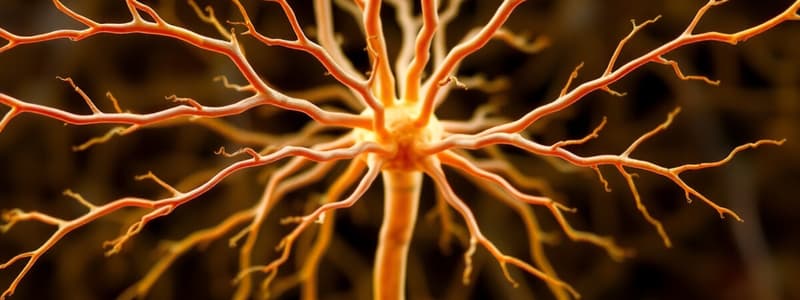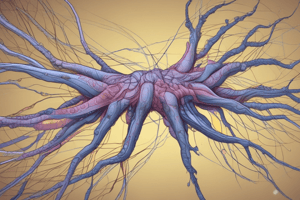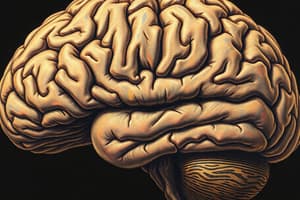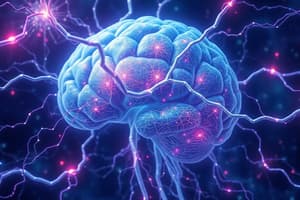Podcast
Questions and Answers
What is the common result of different stimuli on neurons?
What is the common result of different stimuli on neurons?
- Change in permeability of the cell’s plasma membrane (correct)
- Decreased neurotransmitter release
- Increased cell size
- Inhibition of receptor response
Na+ can easily diffuse through the plasma membrane at any time.
Na+ can easily diffuse through the plasma membrane at any time.
False (B)
What excites the cutaneous receptors?
What excites the cutaneous receptors?
Pressure
Light excites the eye receptors, while ____ excites some cutaneous receptors.
Light excites the eye receptors, while ____ excites some cutaneous receptors.
Match the mechanisms with their respective stimulants:
Match the mechanisms with their respective stimulants:
Which of the following is NOT a primary function of the nervous system?
Which of the following is NOT a primary function of the nervous system?
The autonomic nervous system controls voluntary muscle movements.
The autonomic nervous system controls voluntary muscle movements.
What are the two main divisions of the nervous system?
What are the two main divisions of the nervous system?
The ________ nervous system is responsible for involuntary control of bodily functions.
The ________ nervous system is responsible for involuntary control of bodily functions.
Match the following nervous system components with their primary roles:
Match the following nervous system components with their primary roles:
What is the primary function of the motor (efferent) division of the nervous system?
What is the primary function of the motor (efferent) division of the nervous system?
The motor (efferent) division is responsible for regulating automatic body functions, such as heartbeat and digestion.
The motor (efferent) division is responsible for regulating automatic body functions, such as heartbeat and digestion.
What are the two subdivisions of the motor (efferent) division?
What are the two subdivisions of the motor (efferent) division?
The ____ Nervous System allows us to consciously control our skeletal muscles.
The ____ Nervous System allows us to consciously control our skeletal muscles.
Match the following subdivisions of the motor (efferent) division with their primary functions:
Match the following subdivisions of the motor (efferent) division with their primary functions:
Flashcards
Action Potential
Action Potential
The change in a cell's membrane permeability, allowing ions to flow in or out, leading to a brief change in electrical potential.
Sodium Ions (Na+)
Sodium Ions (Na+)
Sodium ions are normally blocked from passing through the membrane of a cell.
Action Potential Initiation
Action Potential Initiation
The process of starting an action potential in a neuron, typically by a stimulus like light, pressure, or neurotransmitters.
Action Potential Generation
Action Potential Generation
Signup and view all the flashcards
Universal Neural Response
Universal Neural Response
Signup and view all the flashcards
What are the general functions of the nervous system?
What are the general functions of the nervous system?
Signup and view all the flashcards
What is the central nervous system (CNS)?
What is the central nervous system (CNS)?
Signup and view all the flashcards
What is the peripheral nervous system (PNS)?
What is the peripheral nervous system (PNS)?
Signup and view all the flashcards
What is the autonomic nervous system (ANS)?
What is the autonomic nervous system (ANS)?
Signup and view all the flashcards
What are the two divisions of the autonomic nervous system?
What are the two divisions of the autonomic nervous system?
Signup and view all the flashcards
Motor (Efferent) Division
Motor (Efferent) Division
Signup and view all the flashcards
Somatic Nervous System
Somatic Nervous System
Signup and view all the flashcards
Autonomic Nervous System
Autonomic Nervous System
Signup and view all the flashcards
Voluntary Control
Voluntary Control
Signup and view all the flashcards
Involuntary Control
Involuntary Control
Signup and view all the flashcards
Study Notes
Nervous System Overview
- The nervous system is the body's master control and communication system, responsible for all actions, thoughts, and emotions.
- It communicates with cells via rapid, specific electrical impulses, resulting in immediate responses.
- The nervous system has two main classifications: structural and functional
- The nervous system has three main functions: sensory input, integration, and motor output.
Structural Classification of NS Organs
-
- Central nervous system (CNS): includes the brain and spinal cord.
- The brain and spinal cord are located within the dorsal cavity.
- They are the integrating and command centers of the nervous system.
- They interpret incoming sensory information and issue instructions for actions based on past experiences and current conditions.
-
- Peripheral nervous system (PNS): includes nerves outside the brain and spinal cord.
- Spinal nerves carry impulses to and from the spinal cord.
- Cranial nerves carry impulses to and from the brain.
- Both systems carry impulses from sensory receptors to the CNS and from the CNS to glands and muscles.
Functional Classifications of PNS Structures
-
- Sensory (afferent) division: carries impulses from sensory receptors to the CNS, keeping the CNS informed of internal and external changes.
- Somatic sensory fibers deliver impulses from skin, skeletal muscles, and joints.
- Visceral sensory fibers transmit impulses from visceral organs.
-
- Motor (efferent) division: carries impulses from the CNS to effector organs (muscles and glands), bringing about a motor response.
- Somatic nervous system: allows voluntary control of skeletal muscles.
- Autonomic nervous system: regulates activities that are automatic or involuntary, like smooth and cardiac muscles and glands. It is further subdivided into the parasympathetic and sympathetic divisions.
Neuron Structure
- Neurons are specialized cells transmitting messages—nerve impulses.
- Major regions:
- Cell body (soma): the metabolic center of the neuron; contains the nucleus and other organelles.
- Processes: fibers extending from the cell body.
- Dendrites: receive signals and conduct impulses toward the cell body.
- Axons: generate nerve impulses and transmit them away from the cell body.
Axons & Nerve Impulses
- Axons have branches called collateral branches.
- Axons end in axon terminals.
- Axon terminals house vesicles containing neurotransmitters, chemicals used to transmit signals across synapses.
- Synapse: a functional junction between neurons where an impulse is transmitted from one neuron to another.
- Neurotransmitters prompt a brief change in the postsynaptic neuron as they are rapidly removed, the synaptic cleft.
Nerve Fiber Coverings
- Myelin sheath is a fatty substance surrounding many nerve fibers.
- It protects and insulates the fibers.
- It increases the speed of nerve impulse transmission.
- Schwann cells are responsible for producing myelin in the PNS.
Neuron Cell Body Locations
- Nuclei: clusters of cell bodies within the CNS (brain and spinal cord).
- Ganglia: small collections of cell bodies outside the CNS.
- Tracts: bundles of nerve fibers traveling within the CNS.
- Nerves: bundles of nerve fibers traveling outside the CNS.
- White matter: composed mostly of myelinated fibers (tracts).
- Gray matter: contains mostly unmyelinated fibers and cell bodies.
Functional Classification of Neurons
- Sensory (afferent) neurons: transmit impulses from sensory receptors to the CNS.
- Motor (efferent) neurons: transmit impulses from the CNS to effectors (muscles and glands).
- Interneurons (association neurons): connect sensory and motor neurons within the CNS.
Reflexes and Reflex Arcs
- Reflexes: rapid, predictable, involuntary responses to stimuli, and always follow the same route.
- Reflex arcs: neural pathways involved in reflexes, which consist of:
- Receptor
- Sensory neuron
- Integration center
- Motor neuron
- Effector
Central Nervous System (CNS) Anatomy and Organization
- The brain—cerebrum, diencephalon, brain stem, cerebellum
- The spinal cord extends from the brain stem
Components of the CNS
- Cerebral Hemispheres
- The most superior part, called the cerebrum. It consists of two hemispheres, with convolutions, such as gyri (ridges) and sulci (grooves).
- Areas on the surface called the cortex consist of gray matter. An underlying layer of white matter. The basal nuclei are islands of gray matter deep within the white matter.
- Functions: includes speech, memory, logical and emotional responses, consciousness, interpretation of sensation, voluntary movement.
- Four major areas, such as the frontal, parietal, occipital, and temporal lobes, each performing specified tasks. Specific areas are located within the lobes.
- Diencephalon (interbrain)
- The structure located between the cerebral hemispheres. Consists of the thalamus and hypothalamus.
- The thalamus functions as a relay station from sensory input to sensory cortex.
- The hypothalamus is an important autonomic center, regulating body temperature, water balance, metabolism, emotion, thirst, and appetites
- The epithalamus forms part of the roof of the diencephalon, including the pineal gland.
- Brain Stem
- Midbrain, pons, medulla oblongata.
- These structures connect the brain to the spinal cord, relaying signals for breathing, heart rate, and other vital activities.
- Cerebellum
- Located inferior to the cerebral hemispheres, it consists of two hemispheres with convoluted surfaces of gray matter and inner white matter.
- Main functions: timing and coordination of skeletal muscle movement, posture maintenance, balance.
Autonomic Nervous System (ANS)
- The ANS is further divided into the sympathetic and parasympathetic divisions. These opposing systems control involuntary functions and are generally antagonistic with opposing actions.
Studying That Suits You
Use AI to generate personalized quizzes and flashcards to suit your learning preferences.
Related Documents
Description
This quiz explores the fundamental functions and components of the nervous system. Participants will match mechanisms with their stimulants, identify divisions of the nervous system, and understand the roles of various receptors. Test your knowledge of how the nervous system operates and its key functions.




